
|
||||||||
|
There are 10 species of seals found in Australian waters and these are either eared seals (Family Otariidae) or true seals (Family Phocidae). They live in areas surrounding the southern states, from New South Wales to Western Australia, and in Antarctic and subantarctic waters. The Australian sea lion and Australian fur seal are only found in Australian waters. Why are we concerned about seals? |
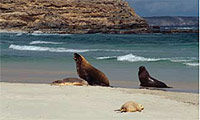 Australian sea lions. (courtesy DEW) |
 Australian sea lions removing rock lobsters (courtesy of Department of Fisheries, WA) |
Commercial sealing started soon after Matthew Flinders discovered fur seals during 1798. The seals were used for oil, leather and meat-meal. Most sealing had finished by 1825, however some continued until the early 1900s when seals were protected in most southern States. Sealing activities reduced seal populations to low numbers across much of southern Australia. Seal biology means their populations are slow to recover once reduced. For example, female Australian sea lions only start to breed when they are about five years old and then have only one pup every 18 months. Also, female sea lions only breed in colonies where they were born. Some seal populations now appear to be recovering. The number of New Zealand fur seals found in Australian waters has been increasing since 1989 and it is generally believed that some populations of Australian fur seal are also recovering but slowly. |
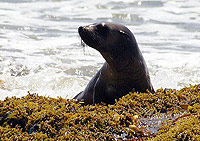 Australian fur seal pup (courtesy of Norm Hanson via Flickr) |
During recent years, some fur seal breeding colonies have expanded significantly and several new colonies have been established. But not all colonies are increasing and many have not re-established following the end of commercial sealing. For example, while New Zealand fur seals have recently returned to breed in Bass Strait it has only been in small numbers. All seal species are now protected nationally under Australian law. And the Australian sea lion, the Southern elephant seal and the Subantarctic fur seal are classified as threatened species because of their declining populations or their small population size. |
How do seals and fisheries interact?
Established seal populations around the coast of southern Australia overlap with productive fishing grounds and the location of many coastal towns and cities. As human populations increase and some seal populations start to recover from past human activities, the overlap between these areas will increase. Seals in search of prey are attracted to fishing nets, rock lobster pots, fish traps and aquaculture farms and will take advantage of easily accessible food source. Seals can bite or remove fish entangled in gillnets, enter nets to collect fish or remove catch or bait from lobster pots or traps. Some fishing gear can accidentally catch or entangle seals. How are fisheries managing these interactions? Fisheries managers, researchers, fishers and aquaculture operators continue to look for new ways to avoid interactions with seals. This includes modifying fishing gear, as well as education and awareness-raising campaigns alerting fishers to ways to avoid seals. |
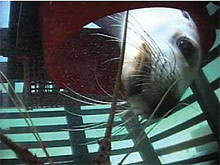 A Sea Lion entering a lobster pot in Western Australia. (courtesy of Department of Fisheries, WA) |
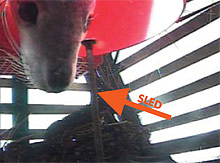 A Sea Lion Excludion Device (SLED) stopping a sea lion from entering a lobster pot in Western Australia. (courtesy of Department of Fisheries, WA) |
Sea Lion Exclusion Devices (SLEDs) In Western Australia a small population of the vulnerable Australian sea lion overlaps the rich fishing grounds for the western rock lobster. Interactions between sea lions and rock lobster pots have occurred over many years. And small sea lion pups can become trapped in pots and drown. To stop sea lions from accidentally drowning Sea Lion Exclusion Devices (SLEDs) have been developed and trialled with fishers. The SLEDs prevent the sea lions from entering the pot but still allow the pot to catch lobsters. From the start of both the commercial and recreational fishing seasons in November 2006, SLEDs must be fitted in all rock lobster pots, in the area near the sea lion colony. |
Seal Excluder Devices (SEDs) Seals often follow fishing boats and sometimes enter fish trawl nets and can accidentally drown. Seal Excluder Devices (SEDs) have been trialled in the winter blue grenadier trawl fishery off west Tasmania. The SEDs are a grid that guides seals out of an opening in the net, while the target fish pass through to the end of the net. Research to understand the interactions between fish trawlers and seals and the use of SEDs is still ongoing and guidelines have been developed to assist fishers in reporting interactions. The fishing industry also has developed a voluntary Code of Fishing Practice aimed at avoiding seals. Find out more
|
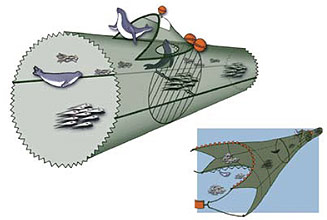 Diagram of the Seal Excluder Device (SED) and escape hatch fitted to a trawl net. Seals encounter the SED while pursuing fish toward the cod-end of the net, but are forced to exit by the escape hatch. © Martin Cawthorn. |
• Department of the Environment and Water Resources (DEW), Seals and Sea Lions:
www.deh.gov.au/coasts/species/seals/index.html• Australian Fisheries Management Authority, Seal Excluder Device:
www.afma.gov.au/information/students/methods/sed.htm
Acknowledgements
This information sheet has been compiled using the expertise and support from a number of sources: Sea lion exclusion devices: A how-to guide for commercial and recreational fishers produced by the Department of Fisheries, Western Australia; The State of the Environment Report, 2001; Assessment of seal-fishery interactions in the winter blue grenadier fishery, produced by BRS; The Action Plan for Australian Seals, produced by P. Shaughnessy for Environment Australia.
